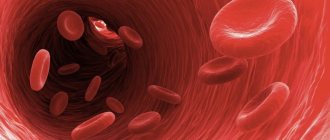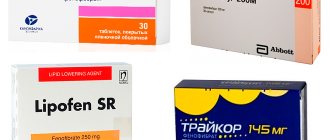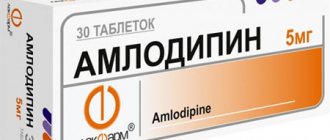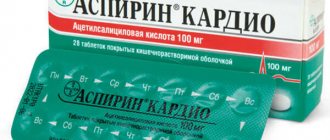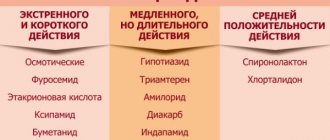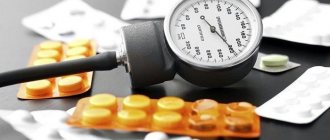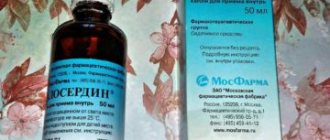general information
Thanks to taking medications of this group, blood vessels dilate, which reduces both the load on the heart muscle and its need for oxygen. This fact allows them to be used as antianginal agents. Peripheral vasodilators include medications that act on resistance vessels and are indicated for the treatment of hypertension. This group of drugs became widely used in the last century, or more precisely, in the fifties. Initially, Phentolamine was used to treat heart failure, but it was not widely used due to the large number of adverse reactions.
The use of medications included in this group should be carried out under the supervision of the attending physician, as they can significantly reduce blood pressure and worsen the blood supply to the heart.
Classification
The modern classification of peripheral vasodilators is based on the action of the drug and the site of its application:
- Effect on blood vessels - mainly Hydralazine and Phentolamine affect arterial vessels, and Prazosin and nitrates affect venous vessels.
- Alpha-adrenergic receptor blockers - Phentolamine, Droperidol, Prazosin, Nifedipine, Hydralazine.
- Converting enzyme inhibitors - Enalapril, Captopril. Medicines promote the conversion of angiotensin 1 to angiotensin 2 and also act on the smooth muscle of small arteries.
- Direct effect on vascular smooth muscle - Prazosin, Sodium Nitroprusside, nitrates.
In addition, peripheral vasodilators are divided into:
- Venous - Molsidomin, Nitroglycerin.
- Arterial - Hydralazine, Phentolamine, Minoxidil.
- Mixed - "Prazosin", "Nifedipine", "Sodium nitroprusside", "Nitroglycerin" and "Molsidomine".
According to the speed of onset of the therapeutic effect:
- Immediate action - “Nitroglycerin”, “Corvaton” for intravenous, sublingual or local external use.
- Delayed - “Prazosin”, “Isosorbide dinitrate”, “Hydralazine”.
Same medicines, but different diseases
Patients are most aware of tablets prescribed for hypertension, osteochondrosis, or vasodilators, which are very useful for the brain and lower extremities, in general, about those medications that treat the most common diseases of our time.
For the brain
For example, for the brain, or rather, for improving its blood supply and nutrition, but depending on the nature of the cerebrovascular accident, representatives of different pharmacological groups are often suitable:
- Calcium antagonists that prevent Ca++ from entering the cell (cinnarizine, nimodipine);
- Myotropic antispasmodics, relaxing the smooth muscles of blood vessels (no-spa, papaverine);
- Ergot alkaloids (due to their alpha-adrenergic blocking ability: dihydroergotoxin, vasobral);
- Drugs that correct cerebral circulation, which are called vascular drugs (Cavinton, Complamin, Trental, nicotinic acid);
- Vasodilators that block adrenergic receptors (adrenergic blockers: atenolol, timolol, propranolol, metoprolol);
- Other drugs that have the ability to act on blood vessels and increase their lumen, thereby improving cerebral circulation (vincamine, chimes, magnesium sulfate, dibazole).
For hypertension
The use of vasodilator drugs for hypertension, as a rule, implies their use for the brain, which, in conditions of vasoconstriction due to arterial hypertension, experiences serious suffering, not receiving nutrients carried by the blood. First of all, these are slow calcium channel blockers and adrenergic blockers.
Meanwhile, the list of drugs prescribed for hypertension is so large that it is simply impossible to list all the representatives. There are times when blood pressure requires immediate and rapid reduction. Of course, medications such as, say, benzohexonium (a ganglion blocker), which can be used in such cases, cannot be prescribed independently. Most of these medications are quite serious and require individual selection and the mandatory participation of a doctor. Examples include:
- Drugs that have a depressing effect on the vasomotor center (clonidine, dopegit);
- Substances that can block the transmission of nerve impulses in the ganglia of the ANS (ganglion blockers): benzohexonium, pentamine, pyrylene;
On the contrary, an attempt to quickly cope with a crisis using, for example, amlodipine (a slow calcium channel blocker) will also not lead to success.
But still, doctors more often have to deal with hypertensive patients, who must take medications that maintain blood pressure at a certain level. As a rule, such drugs are available in tablets or capsules and do not cause trouble to patients. People take them for years, gradually increasing the dosage of “their” medicine, or, on recommendation (and after selection), switch to other groups of vasodilators if the usual pills stop working or cause some kind of side effect.
Thus, in case of hypertension, to maintain blood pressure within normal limits, the following groups of medications are most often prescribed, which, however, are also selected on an individual basis, but are mainly available in pharmacies without a prescription:
- Adrenergic blockers (alpha and beta blockers);
- Slow calcium channel blockers;
- Angiotensin-converting enzyme inhibitors (ACE inhibitors);
- Angiotensin II antagonists;
- Renin inhibitors.
Lists of drugs - the main representatives of the above groups are not given in this section, since a more detailed description of these vasodilators will follow below.
For osteochondrosis
People who are faced with such a problem as cervical osteochondrosis can probably tell that due to such a disease, the vessels of the head are constantly in uncomfortable conditions. All this changes blood pressure, affects the state of memory and attention (the head becomes “heavy” and “difficult to think”), as well as general well-being (pain, discomfort, sleep disturbance, decreased ability to work). The use of vasodilators and damage to other parts of the spine cannot be ruled out. Thus, for osteochondrosis, in addition to anti-inflammatory drugs (NSAIDs), muscle relaxants such as mydocalm, agents that optimize the course of metabolic processes in tissues (mildronate, riboxin) and B vitamins, vasodilators are also used (xanthinol nicotinate, no-spa, papaverine), whose role is to improve blood supply to tissues.
For lower limbs
Vasodilator drugs are also used for diseases of the blood vessels of the arms and legs. However, impaired tissue nutrition as a result of narrowing of blood vessels is more typical for the lower extremities, therefore, the treatment of such pathological conditions is addressed more often and vasodilators, including peripheral vasodilators, are used mainly for the lower extremities (mainly for obliterating endarteritis, atherosclerosis, diabetic angiopathy):
- Myotropic antispasmodics (papaverine, no-shpa, drotaverine);
- Drugs with an adenosine mechanism of action (curantil, parsedil);
- Ergot alkaloids (vasobral, sermion);
- Leukotrienes and prostaglandins (Ventavis, Vazaprostan);
- Purine derivatives (agapurine, trental, pentoxifylline);
- Ganglion-blocking drugs (pentamine, dimecoline, benzohexonium);
- Calcium antagonists (felodipine, nifedipine, octidipine);
- Adrenergic blockers (phentolamine);
- Angiotensin-converting enzyme inhibitors (enalapril, lisinopril, ramipril).
The list of drugs could be continued indefinitely, meanwhile, the reader probably noticed that many groups and names of representatives have already been found in lists recommended for the treatment of other diseases.
Indications for use
Venous vasodilators are indicated for overload of the pulmonary circulation; they:
- reduce pressure in a small circle;
- reduce diastolic expansion of the left ventricle;
- reduce the return of venous blood to the heart;
- reduce oxygen consumption by the myocardium.
Thus, peripheral vasodilators of this subgroup do not increase cardiac output, but only reduce pressure (pressure) in the pulmonary circulation. Medicines with a predominant effect on small arteries reduce afterload, but they do not affect the pressure in the pulmonary circulation, i.e. the level of preload does not change. As a result, the myocardium's need for oxygen decreases, and cardiac output increases. The main side effect of this group of medications is the occurrence of hypotension and an increase in heart rate. Used in the following conditions:
- "Hydralazine" - with low cardiac output, with severe aortic or mitral regurgitation.
- "Phentolamine" - for catecholamine crisis in individuals with pheochromocytoma.
- Dihydropyridines – for the treatment of hypertension.
Drugs that simultaneously act on venules and arterioles affect pre- and afterload, so they are prescribed for the treatment of acute heart failure. And such a unique combination as Hydralazine + Isosorbide dinitrate, used in the treatment of chronic heart failure, helps reduce the risk of mortality within two years of use.
Myotropic vasodilators, calcium channel blockers.
⇐ PreviousPage 31 of 62Next ⇒
The main mechanism of the hypotensive effect of this class of drugs is a decrease in smooth muscle tone and vasodilation. A decrease in vascular tone is achieved through various mechanisms: blockade of calcium channels of vascular smooth muscle cells, activation of potassium channels of these cells, due to the effect on smooth muscle cells of nitric oxide, which is released from the molecule of the substance, etc. The following groups of vasodilators of myotropic action are distinguished.
1) Calcium channel blockers
(see section 20.1. “Antianginal drugs”) Calcium ions are important in coupling the excitation-contraction mechanism in vascular smooth muscle cells. When the membrane is depolarized, ionized calcium enters the cell through voltage-gated L-type calcium channels, which leads to an increase in the concentration of cytoplasmic calcium, which, in combination with calmodulin, activates
myosin light chain kinase. As a result, phosphorylation of myosin light chains increases, which promotes the interaction of actin with myosin and smooth muscle contraction. Impaired penetration of calcium ions into the cell prevents this process and leads to a decrease in vascular tone and hypotension.
Among calcium channel blockers, dihydropyridine derivatives have the greatest affinity for vascular smooth muscle cells: nifedipine, nitrendipine, isradipine, amlodipine, felodipine, lacidipine, etc.
Dihydropyridine derivatives are powerful vasodilators, dilate arterial vessels, resulting in a decrease in blood pressure, resulting in reflex tachycardia.
Nifedipine causes a rapid hypotensive effect, the drug is recommended for rapid reduction of blood pressure sublingually or orally; when taken sublingually, it has a hypotensive effect within 15 minutes, which makes it possible to use nifedipine in hypertensive crises. The action of nifedipine lasts 6-8 hours. Short-acting forms of nifedipine (Corinfar, Phenigidine, etc.) are not recommended for systematic use. In this case, prolonged preparations of nifedipine are used (Corinfar retard, Cordaflex retard, Adalat SP, etc.) with a slow release of the active substance (effective for 12 or 24 hours). For the systematic treatment of hypertension, long-acting dihydropyridine derivatives amlodipine (Norvasc), felodipine (Plendil), lacidipine (Latsipil) are used. These drugs are prescribed once a day (duration of action is 24 hours). Side effects of dihydropyridine derivatives: nausea, dizziness, reflex tachycardia, swelling of the ankles.
Verapamil and other phenylalkylamine derivatives, as well as diltiazem (a benzothiazepine derivative), due to their greater affinity for cardiomyocytes, reduce the strength and frequency of heart contractions (reduce cardiac output), which is an essential component of their hypotensive effect. In addition, they have a vasodilating myotropic effect - they moderately dilate arterial vessels, which also leads to a decrease in blood pressure. These drugs are used less frequently as antihypertensive drugs than dihydropyridine derivatives. Verapamil is mainly used as an antiarrhythmic and antianginal agent. Side effects of vera-pamil: nausea, dizziness, bradycardia, heart failure, difficulty in atrioventricular conduction, swelling of the ankles, constipation.
INDAPAMIDE
Its structure and action are similar to clopamide; is its indolinyl analogue.
Like clopamide, it has a diuretic and antihypertensive effect. In patients with hypertension, it reduces peripheral vascular tone and total peripheral resistance.
Prescribed mainly for hypertension stages I and II.
The drug is usually well tolerated, but the same precautions must be taken as when using other similar diuretics.
DILTIAZEM
A calcium ion antagonist used for angina (including Prinzmetal's angina) and hypertension. It has a negative chronotropic effect and reduces heart rate. May slow down atrioventricular conduction and reduce the excitability of the atrioventricular node. Reduces vascular tone and total peripheral resistance in hypertension. The antianginal effect is associated with a decrease in preload on the myocardium, dilatation of coronary vessels and improved oxygen supply to the heart. It also has antiarrhythmic activity.
The action of diltiazem is close to verapamil, but has a slightly stronger effect on vascular smooth muscle and the conduction system of the heart. Compared with nifedipine, the peripheral vasodilator effect and reflex tachycardia are less pronounced.
Used for various forms of coronary artery disease and hypertension.
Diltiazem is prescribed orally. Doses are selected individually.
The drug is usually well tolerated, but monitoring of efficacy and tolerability is necessary. If the effect is insufficient, other drugs are added.
NIFEDIPINE
Nifedipine (phenigidine) is the main representative of calcium ion antagonists.
Like verapamil and other calcium ion antagonists, nifedipine dilates coronary and peripheral (mainly arterial) vessels, has a negative inotropic effect, and reduces myocardial oxygen demand. Unlike verapamil, it does not have an inhibitory effect on the conduction system of the heart and has weak antiarrhythmic activity. Compared with verapamil, it reduces peripheral vascular resistance more strongly and reduces blood pressure more significantly.
The drug is rapidly absorbed when taken orally. The maximum concentration in blood plasma is observed 1/2 - 1 hour after administration. It has a short half-life - 2 - 4 hours. About 80% is excreted by the kidneys in the form of inactive metabolites, about 15% in feces. It has been established that with long-term use (2 - 3 months), tolerance (unlike verapamil) to the action of the drug develops.
Nifedipine (phenigidine) is used as an antianginal agent for ischemic heart disease with angina attacks, to reduce blood pressure in various types of hypertension, including renal hypertension. There are indications that nifedipine (and verapamil) in nephrogenic hypertension slows the progression of renal failure.
Also used in complex therapy of chronic heart failure. Previously, it was believed that nifedipine and other calcium ion antagonists are not indicated for heart failure due to the negative inotropic effect. Recently, it has been found that all these drugs, due to their peripheral vasodilator action, improve heart function and help reduce its size in chronic heart failure. There is also a decrease in pressure in the pulmonary artery. However, the possibility of a negative inotropic effect of nifedipine should not be excluded; caution should be exercised in cases of severe heart failure. Recently, reports have appeared about the inappropriateness of using nifedipine for arterial hypertension, due to an increased risk of myocardial infarction, as well as the possibility of an increased risk of death in patients with coronary heart disease with long-term use of idenfat.
This mainly concerns the use of “regular” nifedipine (short-acting), but not its prolonged dosage forms and long-acting dihydropyridines (for example, amlodipine). This question, however, remains debatable.
To relieve a hypertensive crisis (and sometimes during angina attacks), the drug is used sublingually. To speed up the effect, the phenigidine tablet is chewed and held, without swallowing, under the tongue. With this method, patients should remain in a supine position for 30–60 minutes. If necessary, repeat taking the drug after 20-30 minutes. After stopping the attacks, they switch to oral administration.
The latest results suggest that the sublingual use of nifedipine is inappropriate, due to the increased risk of side effects, with a rapid increase in the “peak” concentration of the drug in the blood.
Phenigidine (nifedipine) is generally well tolerated. However, redness of the face and skin of the upper torso and headache are relatively common, probably associated with a decrease in the tone of the cerebral vessels of the brain (mainly capacitive) and their stretching due to an increase in blood flow through arteriovenous anastomoses. In these cases, the dose is reduced or the drug is taken after meals.
Palpitations, nausea, dizziness, swelling of the lower extremities, hypotension, and drowsiness are also possible.
Contraindications: severe forms of heart failure, sick sinus syndrome, severe arterial hypotension. For moderate hypotension, the drug is prescribed in reduced doses under mandatory blood pressure monitoring.
Nifedipine (phenigidine) is contraindicated during pregnancy and breastfeeding.
Caution is needed when prescribing the drug to transport drivers and people in other professions that require a quick mental and physical reaction.
⇐ Previous31Next ⇒
Recommended pages:
Use the site search:
Pharmacological action of vasodilators
The mechanism of action of peripheral vasodilators is different; this group includes drugs:
- blocking alpha-adrenergic receptors;
- calcium ion antagonists;
- influencing smooth myofibrils of arterioles;
- converting enzyme inhibitors.
Despite the different mechanism of action, all drugs affect post- and preload of the myocardium. Pharmacodynamic effects are manifested by a decrease in blood flow to the heart due to an increase in the capacity of the venous part of the vascular bed, and minute blood volume, due to an increase in the capacity of the arterial part of the autonomic vascular system.
The mechanism of development of the vasodilating effect
You can expand the vascular bed:
- relaxing the smooth muscles of blood vessels;
- influencing the nerve fibers that innervate the blood vessels;
- effects through the humoral systems with the help of vasodilators that are carried through the bloodstream throughout the body.
The expansion of the lumen of blood vessels is a natural reaction of the body, which improves blood supply to organs. They receive more oxygen and nutrients. So, when the blood vessels in the brain dilate, mental activity increases.
With the development of the inflammatory process, the vasodilatory effect is observed under the influence of inflammatory mediators (bradykinin, prostaglandins). Increasing blood supply helps eliminate the causes that provoked the inflammatory process and restore damaged tissue.
Application of the vasodilating effect in medical practice
The vasodilating effect of drugs in medicine is used for:
- redistribution of blood in the body, for example, during surgery on a “dry” heart;
- a decrease in the rate of blood circulation and a decrease in pressure with hypertension and;
- normalization of trophism and acceleration of regeneration of damaged tissues, after injuries, focal necrosis and general vascular damage during.
The mechanism of action of drugs with the international nonproprietary name "Pentoxifylline"
The accumulation of cyclic adenosine monophosphate in the cellular tissue of vascular smooth muscles and in blood cells, as well as inhibition of phosphodiesterase, underlies the mechanism of action of Pentoxifylline, a peripheral vasodilator, the administration of which:
- Improves symptoms of cerebrovascular accidents by reducing total peripheral resistance and slightly dilating coronary vessels. Shows a slight vasodilating effect.
- Inhibits the aggregation of red blood cells and platelets, stimulates fibrinolysis, reduces the concentration of fibrinogen in blood plasma, improving its viscosity.
Diverse group
Vasodilator drugs are capable of influencing vascular walls in various ways (depending on their mechanism of action), reducing their tone and, due to this, increasing the diameter of blood vessels, improving blood flow in them. However, not all pharmaceuticals classified in this category affect different types of blood vessels to the same extent.
expansion of the vessel and improvement of blood flow under the influence of a vasodilator.
In this case, it can be assumed that the heart vessels are unlikely to “feel” the effect of previous drugs; they need their own, special drugs, which is actually what happens. To dilate the coronary vessels in the treatment of angina or heart failure, drugs from the group of cardiac vasodilators are prescribed.
- Drugs acting on arterioles (direct arterial vasodilators): alpha-non-selective adrenergic blockers (AB), hydralazine, calcium antagonists;
- Medicines whose “circle of interest” includes venules: organic nitrates (nitroglycerin, nitrong);
- Drugs that have a simultaneous effect on some (arterioles) and other (venules) vessels: inorganic nitrates, alpha-1-nonselective ABs.
In addition, the modern pharmacological industry also has vasodilators that are endowed with the ability to increase the lumen of large-caliber vessels and highways. These are systemic vasodilators; they are able to quickly reduce blood pressure and increase the intensity of blood supply in all tissues of the body.
applicability of vasodilators depending on the pharmacological group
Before prescribing drugs of one group or another, the doctor studies not only the patient’s condition caused by the pathological process occurring in his body, but also takes into account the condition of the patient’s blood vessels.
Medicine "Vazonit"
It is a long-acting (prolonged) action medicine. Pentoxifylline is an active substance that contains 600 mg in one dosage form. Thanks to taking the drug "Vazonit 600":
- microcirculation improves in places where blood flow is disrupted;
- due to the effect on deformed red blood cells, blood fluidity improves;
- the elasticity of the red blood cell membrane increases;
- increased blood viscosity decreases;
- platelet aggregation is blocked.
The drug is completely absorbed from the gastrointestinal tract. The extended form promotes uninterrupted flow of the active substance into the bloodstream. The maximum concentration in the blood is reached after three to four hours and persists for approximately twelve hours. More than ninety percent of the converted pentoxifylline is excreted by the kidneys.
Indications for the use of drugs with the INN pentoxifylline
Doctors recommend Vazonit 600, as well as other drugs containing the active ingredient pentoxifylline, for the following conditions:
- Failure of blood flow of ischemic origin, acute and chronic.
- Brain damage is discirculatory and atherosclerotic.
- Failure of peripheral circulation occurring against the background of inflammatory, as well as atherosclerotic and diabetic processes.
- As a symptomatic remedy for treating the consequences that arose after cerebrovascular accidents.
- Failure of the functions of the middle ear of vascular origin, which is accompanied by hearing loss.
- Disruption of blood circulation in the vessels of the eye.
- Trophic tissue disorders caused by failure of venous and arterial microcirculation.
Contraindications and side effects of drugs containing the active substance pentoxifylline
According to the instructions for use of "Pentilin" and other drugs with the INN pentoxifylline, they are prohibited for use when:
- Hypersensitivity to pentoxifylline.
- Pregnancy.
- Natural feeding.
- Retinal hemorrhage.
- Heavy bleeding.
- Acute myocardial infarction.
- Under the age of eighteen.
Adverse events may occur from:
- hemostatic and cardiovascular systems;
- subcutaneous fat and skin;
- CNS;
- digestive system.
As well as allergic reactions and changes in some laboratory parameters.
Mechanism of action
Vasodilating effect is a natural physiological reaction of blood vessels to various influences. Vessels can narrow or dilate, increasing the lumen, which also increases the amount of circulating blood. The effect of expanding the lumen of blood vessels can be either local (local, in a certain area of the body) or occur throughout the body.
In the kidneys and retina of the eye, for example, microcirculation is developed, i.e. an extensive network of small arteries and arterioles; there are also large main vessels, the expansion of which leads to a rapid decrease in blood pressure and saturation of all organs and tissues with a sufficient amount of blood. Completely different mechanisms, if we talk about drugs, regulate the dilation of blood vessels in the cardiovascular system or the skin, organs and tissues, which include the limbs.
Vasodilation plays an important role in the process of thermoregulation. As the ambient temperature increases, blood vessels dilate; low temperatures provoke constriction of blood vessels so that the skin gives off less heat, retaining it for the normal functioning of the body. In addition to physical factors (exposure to heat, ultraviolet radiation), the vasodilating effect can be caused by:
- mechanical influence (for example, massage);
- physiologically - after eating, during physical activity or mental work;
- for any local or general inflammatory process;
- chemical (i.e. using medications).
In medicine, a general or local vasodilating effect is caused artificially using a group of special pharmacological drugs or some folk remedies.
The drug "Agapurin retard"
The active ingredient of this medicine is also pentoxifylline, of which there is 400 mg in one tablet. After administration, the active substance is gradually released from the dosage form and uniformly enters the bloodstream. In addition to improving microcirculation, the drug has an angioprotective effect. Indications for prescribing the medication are disorders of:
- blood circulation of the eye;
- cerebral circulation (ischemic);
- functional acute inner ear;
- venous and peripheral arterial blood flow provoked by diabetes mellitus, atherosclerosis;
- trophism as a result of varicose ulcerative lesions, frostbite, gangrene;
- peripheral arterial and venous circulation occurring against the background of processes such as infectious, diabetic, atherosclerotic.
And also for angioneuropathy and conditions after a stroke, both hemorrhagic and ischemic.
In individuals with diabetes mellitus, dosage adjustments of antidiabetic agents are often required. Otherwise, the risk of hypoglycemia is high. The drug is taken twice a day at the same time, it is well tolerated. Adverse reactions are rare.
A medicinal product with the INN “Vincamine”
"Vinoxin MV" has a selective vasoregulatory effect on cerebral circulation. Thanks to the intense oxidation of glucose, it improves brain metabolism. The oxygen supply to neurons improves. Peripheral cerebral vascular resistance stabilizes. In addition, the drug does not have a negative effect on the liver and kidneys. Doctors recommend Vinoxin MV to normalize cerebral circulation in cases of disorders:
- mental;
- concentration;
- memory;
- vision and hearing of vascular origin;
- post-traumatic traumatic brain injury;
- cerebral (after cerebral ischemia);
- and others.
The duration of the course of treatment is selected by the doctor individually. Its use is not recommended for pathologies that provoke an increase in intracranial pressure, acute stroke, heart rhythm disturbances, as well as for children, pregnant and lactating women. Side effects are minor. You should not increase the dose recommended by your doctor. With long-term use, monitoring of liver condition is necessary.
List of drugs
Vasodilators are a very large pharmacological group. List of some funds:
- no-shpa. Quickly relieves spasm, due to which pain goes away and blood circulation improves;
- nitroglycerine. Relaxes the smooth muscles of blood vessels. Quickly eliminates angina pectoris;
- glycine is an amino acid that can dilate blood vessels in the brain, improving its nutrition, concentrating attention, and memory;
- hood Fast-acting drug. Eliminates hypertensive crisis, prohibited for cardiac cough;
- piracetam. Medicine for the treatment of vascular diseases. It is a nootropic, antihypoxic agent;
- trental. Another name for it is pentoxifylline, it improves microcirculation in the brain, dilates blood vessels, reduces platelet aggregation;
- Molsidomine Reduces the tone of peripheral vessels, reduces the volume of venous blood, relieves spasm of the heart muscle;
- cinnarizine. Nootropic. Blocks calcium channels in arteries. Dilates blood vessels and improves blood supply to the brain;
- papaverine. Myotropic antispasmodic. Dilates blood vessels, relieving spasm. Reduces smooth muscle tension;
- apressin. New generation drug. Reduces the resistance of arterial walls, resulting in lower blood pressure. Relieves afterload on the heart.
These are just a few commonly known medications. Among all vasodilators, there are hundreds of drugs.
Peripheral drugs
Currently, a large number of drugs have been developed that have a selective effect and are successfully used to treat heart failure and hypertension. Below is a list of vasodilator drugs:
- "Agapurin".
- "Benziclamane fumarate."
- "Duzopharm".
- "Complamine."
- "Nitsergoline".
- "Pentamon".
- "Pentoxifylline."
- "Pentilin."
- "Pentomer".
- "Radomin".
- "Ralofect"
- "Sermion."
- "Furazolidone" and others.
Each drug has different pharmacological effects. For successful treatment of pathology, it is important to choose the right remedy. To avoid unpleasant consequences, before using the medicine, you should read the instructions for use and follow all the recommendations of your doctor.


